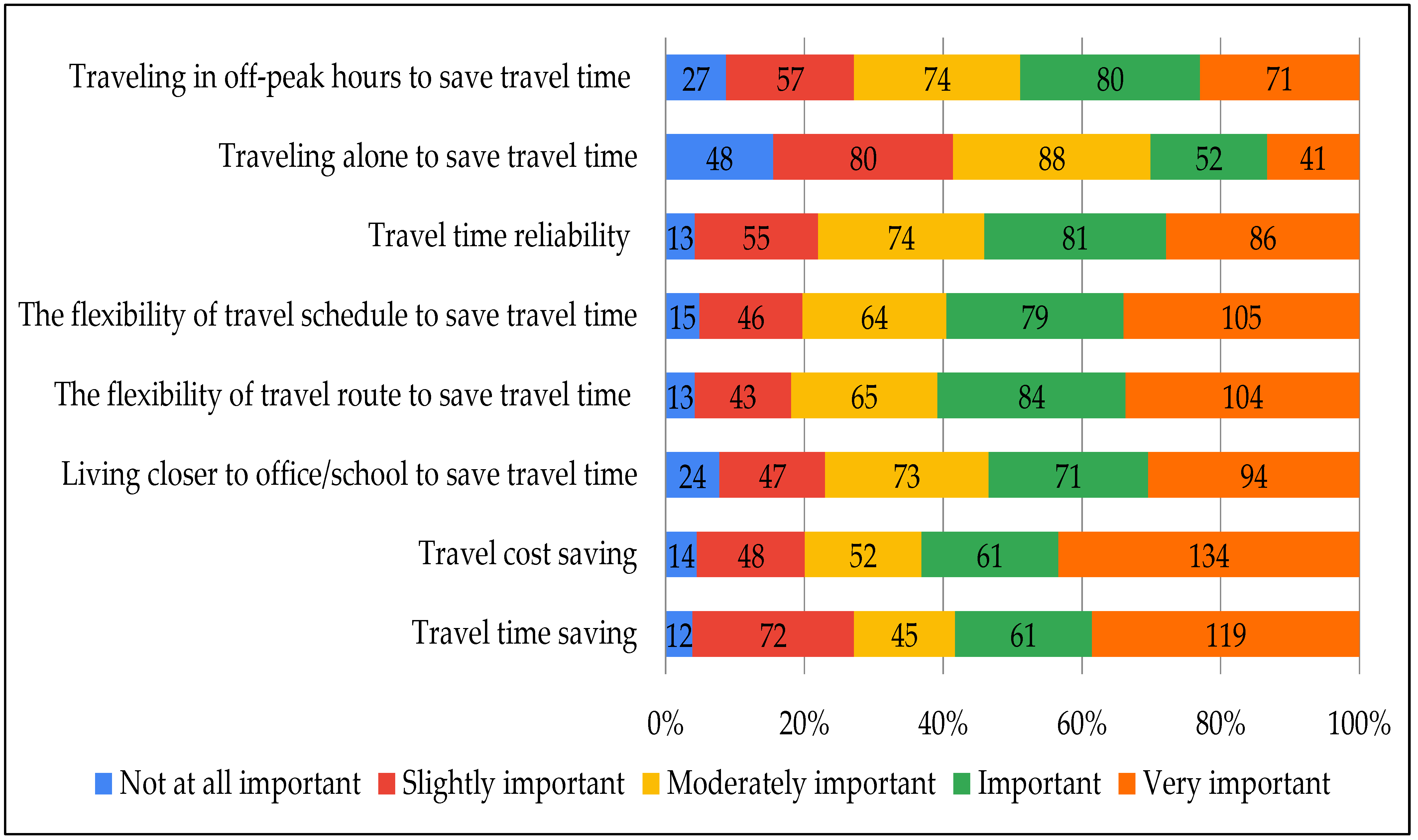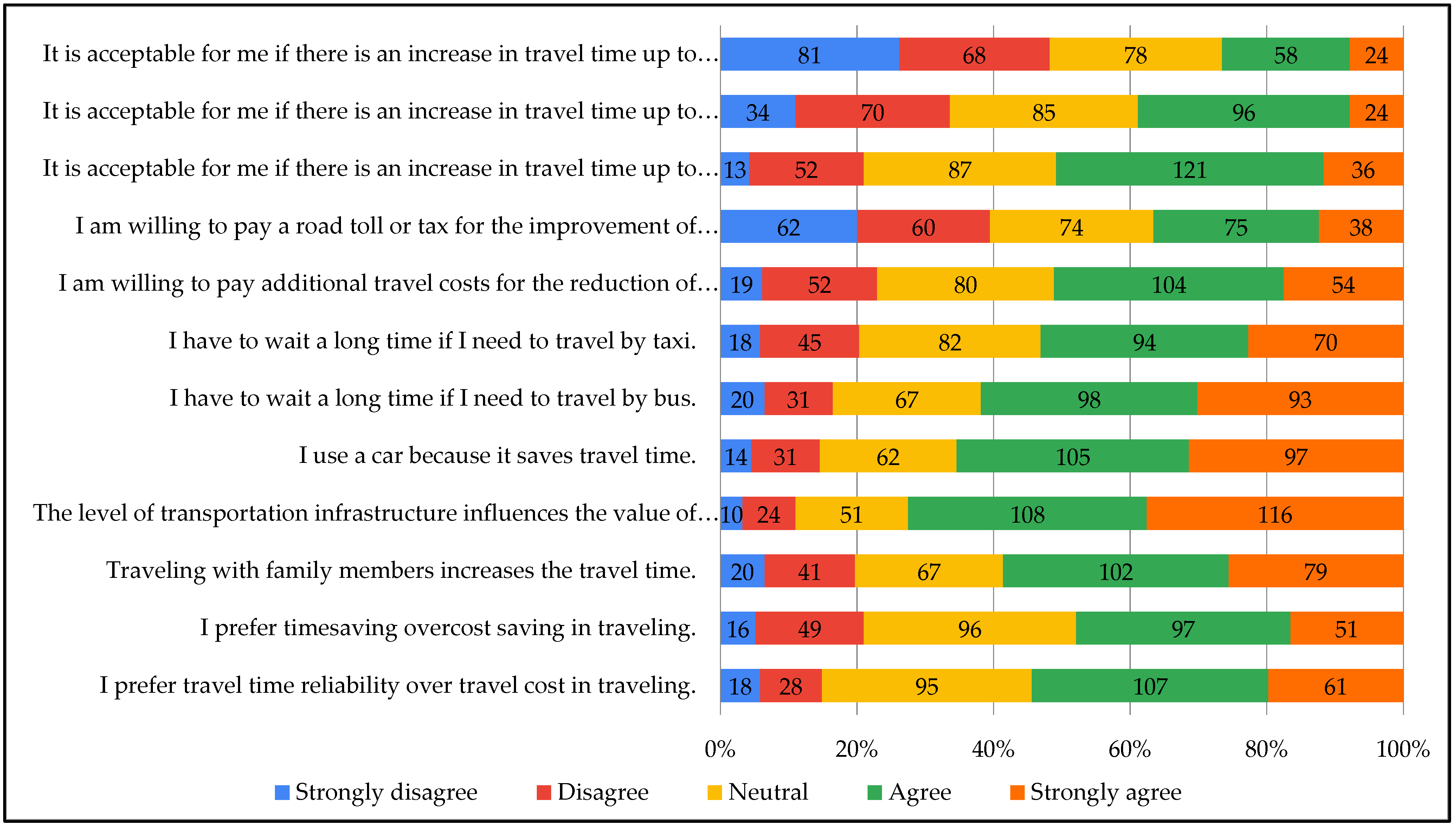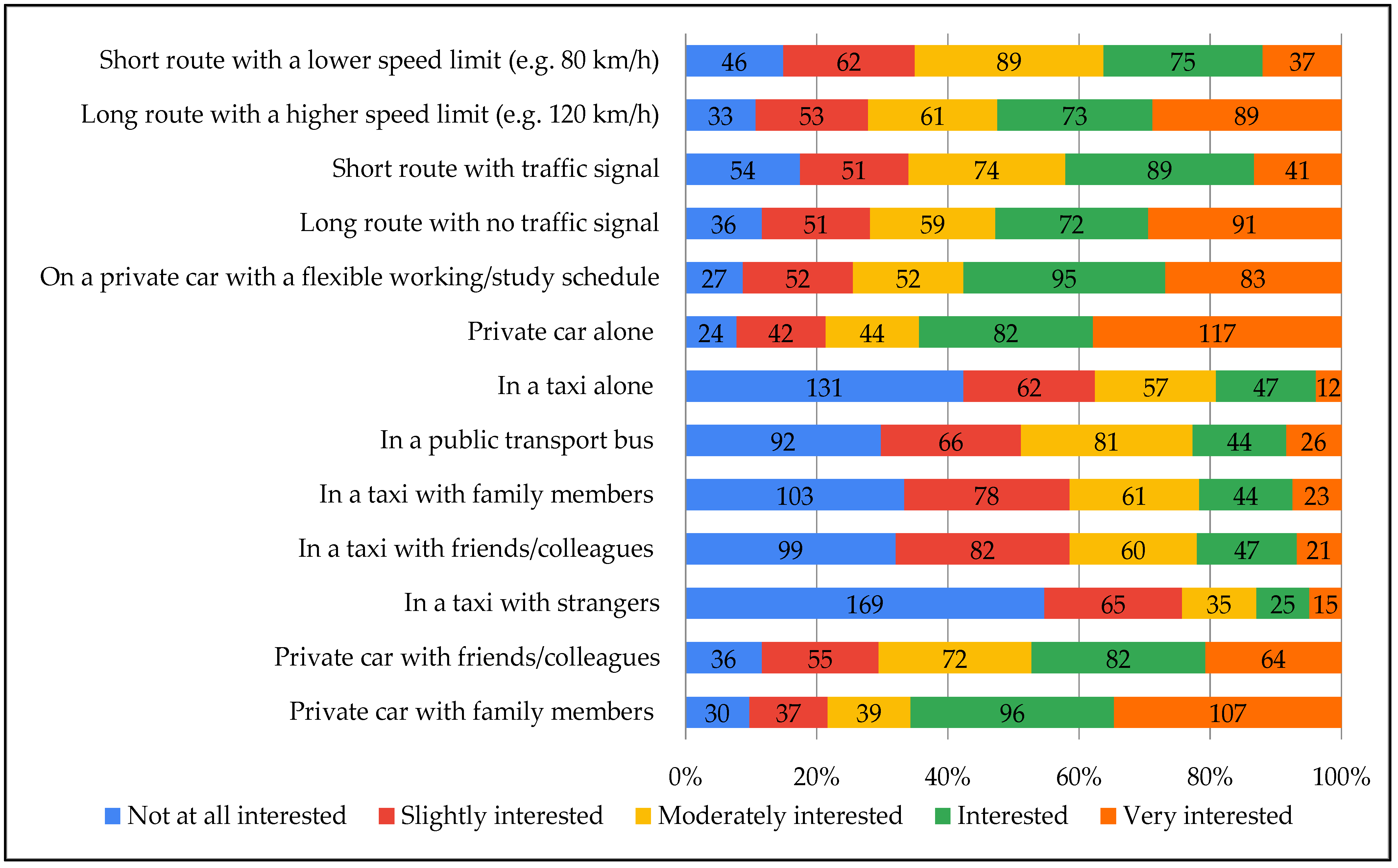Travelers’ Perceptions on Significance of Travel Time Saving Attributes in Travel Behavior: A Case Study in Oman
Abstract
1. Introduction
2. Literature Review
3. Data Collection and Analysis Methods
3.1. Selection of Survey Locations and Sample Size
3.2. Questionnaire Design
3.3. Data Analysis Methods
4. Results and Discussions
4.1. Distribution of Respondents’ Personal and Traveling Characteristics
4.2. Distribution of Respondents’ Travelling Information
4.3. Distribution of Respondents’ Travel Time Saving Importance
4.4. Distribution of Respondents’ Mode Choice Behaviors
4.5. Distribution of Respondents’ Level of Interests in Different Scenarios for Travel Time Saving
4.6. Distribution of Respondents’ Willingness to Pay for Various Levels of Travel Time Saving
4.7. Factor Analysis of Important Travel Time Saving Attributes
4.8. Factor Analysis of Preferences in Traveling
4.9. Factor Analysis of Respondents’ Travel Interests Considering Travel Time Saving
4.10. Regression Analysis of Travelers’ Time Saving Interests
4.11. Discussion on Results
5. Conclusions
Author Contributions
Funding
Institutional Review Board Statement
Informed Consent Statement
Data Availability Statement
Acknowledgments
Conflicts of Interest
References
- National Center for Statistics and Information. Monthly Statistical Bulletin. Available online: https://www.ncsi.gov.om/Elibrary/Pages/LibraryContentDetails.aspx?ItemID=MgTlAFqddgBeormy3YBZDg%3D%3D (accessed on 7 May 2022).
- Worldometer Oman Demographics 2020 (Population, Age, Sex, Trends)—Worldometer. Available online: https://www.worldometers.info/demographics/oman-demographics/ (accessed on 31 May 2022).
- Al Subhi, A.K. Women’s Representation in Majlis Al Shura in Oman: How Do Gender Ideology, Islam, and Tribalism Matter? Iowa State University, Digital Repository: Ames, IA, USA, 2016. [Google Scholar]
- Javid, M.A.; Al-Hashmi, W.Y.; Al-Shaqsi, A.S. Exploring the Student’s Perceptions on Safety Aspects of the University of Nizwa Bus Service in Oman. Iran. J. Sci. Technol.—Trans. Civ. Eng. 2020, 45, 227–239. [Google Scholar] [CrossRef]
- Belwal, R. People’s Perception of Public Transport Services in Oman. J. Teknol. Sci. Eng. 2013, 65, 9–16. [Google Scholar] [CrossRef][Green Version]
- Belwal, R.; Belwal, S. Public Transportation Services in Oman: A Study of Public Perceptions. J. Public Transp. 2010, 13, 1. [Google Scholar] [CrossRef]
- Carrion, C.; Levinson, D. Value of Travel Time Reliability: A Review of Current Evidence. Transp. Res. Part A Policy Pract. 2012, 46, 720–741. [Google Scholar] [CrossRef]
- Martens, K.; Di Ciommo, F. Travel Time Savings, Accessibility Gains and Equity Effects in Cost–Benefit Analysis. Transp. Rev. 2017, 37, 152–169. [Google Scholar] [CrossRef]
- Batley, R.; Bates, J.; Bliemer, M.; Börjesson, M.; Bourdon, J.; Cabral, M.O.; Chintakayala, P.K.; Choudhury, C.; Daly, A.; Dekker, T.; et al. New Appraisal Values of Travel Time Saving and Reliability in Great Britain. Transportation 2019, 46, 583–621. [Google Scholar] [CrossRef]
- Barrett, J. The Impact of Transportation Infrastructure on the Value of Time; University of California: Los Angeles, CA, USA, 2010. [Google Scholar]
- Schmid, B.; Molloy, J.; Peer, S.; Jokubauskaite, S.; Aschauer, F.; Hössinger, R.; Gerike, R.; Jara-Diaz, S.R.; Axhausen, K.W. The Value of Travel Time Savings and the Value of Leisure in Zurich: Estimation, Decomposition and Policy Implications. Transp. Res. Part A Policy Pract. 2021, 150, 186–215. [Google Scholar] [CrossRef]
- Burris, M.; Spiegelman, C.; Abir, A.K.M.; Lee, S. Value of Travel Time. Available online: https://static.tti.tamu.edu/tti.tamu.edu/documents/PRC-2016-4.pdf (accessed on 7 May 2022).
- Athira, I.C.; Muneera, C.P.; Krishnamurthy, K.; Anjaneyulu, M.V.L.R. Estimation of Value of Travel Time for Work Trips. Transp. Res. Procedia 2016, 17, 116–123. [Google Scholar] [CrossRef]
- Shariff, N.M.; Shah, M.Z. Factors Influencing Travel Behavior and Their Potential Solution: A Review of Current Literatures. J. Alam Bina 2008, 11, 19–28. [Google Scholar]
- Dewi, A.U. Research on Factors Affecting Travel Behaviour on Choice of Transportation Means for Working Activity: A Case Study in Yog Yakarta City, Indonesia; Karlstads University: Karlstad, Sweden, 2010. [Google Scholar]
- Vrtic, M.; Schuessler, N.; Erath, A.; Axhausen, K.W. The Impacts of Road Pricing on Route and Mode Choice Behaviour. J. Choice Model. 2010, 3, 109–126. [Google Scholar] [CrossRef][Green Version]
- Shao, C.Q.; Liu, Y.; Liu, X.M. Valuation of Travel Time Savings in Viewpoint of WTA. Comput. Intell. Neurosci. 2014, 2014. [Google Scholar] [CrossRef]
- Kato, H.; Fujiu, M. How does the value of travel time saving vary over the individual’s income? J. East. Asia Soc. Transp. Stud. 2007, 7, 128–140. [Google Scholar] [CrossRef]
- Van Wee, B.; Rietveld, P.; Meurs, H. Is Average Daily Travel Time Expenditure Constant? In Search of Explanations for an Increase in Average Travel Time. J. Transp. Geogr. 2006, 14, 109–122. [Google Scholar] [CrossRef]
- Bouscasse, H.; de Lapparent, M. Perceived Comfort and Values of Travel Time Savings in the Rhône-Alpes Region. Transp. Res. Part A Policy Pract. 2019, 124, 370–387. [Google Scholar] [CrossRef]
- Román, C.; Martín, J.C.; Espino, R.; Cherchi, E.; de Dios Ortúzar, J.; Rizzi, L.I.; González, R.M.; Amador, F.J. Valuation of Travel Time Savings for Intercity Travel: The Madrid-Barcelona Corridor. Transp. Policy 2014, 36, 105–117. [Google Scholar] [CrossRef]
- Jara-Diaz, S.R. Consumer’s Surplus and the Value of Travel Time Savings. Transp. Res. Part B 1990, 24, 73–77. [Google Scholar] [CrossRef]
- Jara-Díaz, S.R. Allocation and Valuation of Travel-Time Savings. In Handbook of Transport Modelling; Hensher, D.A., Button, K.J., Eds.; Emerald Group Publishing Limited: Bingley, UK, 2007; Volume 1, pp. 363–379. ISBN 978-0-08-045376-7. [Google Scholar]
- Jara Díaz, S.R.; Guevara, C.A. Behind the Subjective Value of Travel Time Savings: The Perception of Work, Leisure, and Travel from a Joint Mode Choice Activity Model. J. Transp. Econ. Policy 2003, 37, 29–46. [Google Scholar]
- Zhu, Z.; Chen, H.; Ma, J.; He, Y.; Chen, J.; Sun, J. Exploring the Relationship between Walking and Emotional Health in China. Int. J. Environ. Res. Public Health 2020, 17, 8804. [Google Scholar] [CrossRef]
- Zhu, Z.; Chen, H.; Chen, J.; Ma, J.; He, Y. The Effect of Commuting Time on Job Stress in Obese Men With Different Exercise Frequency in China. Am. J. Mens. Health 2020, 14, 1557988320975542. [Google Scholar] [CrossRef]
- Malichová, E.; Pourhashem, G.; Kováĉiková, T.; Hudák, M. Users’ Perception of Value of Travel Time and Value of Ridesharing Impacts on Europeans’ Ridesharing Participation Intention: A Case Study Based on MoTiV European-Wide Mobility and Behavioral Pattern Dataset. Sustainability 2020, 12, 4118. [Google Scholar] [CrossRef]
- Vagias, W.M. Likert-Type Scale Response Anchors. Available online: https://www.crcaih.org/assets/Resources/sample-scales.pdf (accessed on 30 May 2022).
- Taber, K.S. The Use of Cronbach’s Alpha When Developing and Reporting Research Instruments in Science Education. Res. Sci. Educ. 2018, 48, 1273–1296. [Google Scholar] [CrossRef]
- Tavakol, M.; Dennick, R. Making Sense of Cronbach’s Alpha. Int. J. Med. Educ. 2011, 2, 53–55. [Google Scholar] [CrossRef] [PubMed]
- De Oña, J.; De Oña, R.; Eboli, L.; Mazzulla, G. Perceived Service Quality in Bus Transit Service: A Structural Equation Approach. Transp. Policy 2013, 29, 219–226. [Google Scholar] [CrossRef]
- Wang, Y.; Cao, M.; Liu, Y.; Ye, R.; Gao, X.; Ma, L. Public Transport Equity in Shenyang: Using Structural Equation Modelling. Res. Transp. Bus. Manag. 2020, 42, 100555. [Google Scholar] [CrossRef]
- Javid, M.A.; Al-Roushdi, A.F.A. Causal Factors of Driver’s Speeding Behaviour, a Case Study in Oman: Role of Norms, Personality, and Exposure Aspects. Int. J. Civ. Eng. 2019, 17, 1409–1419. [Google Scholar] [CrossRef]
- Javid, M.A.; Ali, N.; Abdullah, M.; Shah, S.A.H. Integrating the Norm Activation Model (NAM) Theory in Explaining Factors Affecting Drivers’ Speeding Behaviour in Lahore. KSCE J. Civ. Eng. 2021, 25, 2701–2712. [Google Scholar] [CrossRef]
- Javid, M.A.; Al-Hashimi, A.R. Significance of Attitudes, Passion and Cultural Factors in Driver’s Speeding Behavior in Oman: Application of Theory of Planned Behavior. Int. J. Inj. Contr. Saf. Promot. 2020, 27, 172–180. [Google Scholar] [CrossRef]
- Javid, M.A.; Al-Neama, M.Y. Identification of Factors Causing Driver’s Distraction in Oman. J. Appl. Eng. Sci. 2018, 16, 153–160. [Google Scholar] [CrossRef]
- Sahoo, M. Structural Equation Modeling: Threshold Criteria for Assessing Model Fit. In Methodological Issues in Management Research: Advances, Challenges, and the Way Ahead; Emerald Publishing Limited: Bingley, UK, 2019; pp. 269–276. [Google Scholar] [CrossRef]
- Bentler, P.M.; Bonett, D.G. Significance Tests and Goodness of Fit in the Analysis of Covariance Structures. Psychol. Bull. 1980, 88, 588–606. [Google Scholar] [CrossRef]
- Javid, M.A.; Okamura, T.; Nakamura, F.; Tanaka, S.; Wang, R. People’s Behavioral Intentions towards Public Transport in Lahore: Role of Situational Constraints, Mobility Restrictions and Incentives. KSCE J. Civ. Eng. 2016, 20, 401–410. [Google Scholar] [CrossRef]
- Klöckner, C.A.; Friedrichsmeier, T. A Multi-Level Approach to Travel Mode Choice—How Person Characteristics and Situation Specific Aspects Determine Car Use in a Student Sample. Transp. Res. Part F Traffic Psychol. Behav. 2011, 14, 261–277. [Google Scholar] [CrossRef]




| Internal Factors | External Factors |
|---|---|
|
|
|
|
| Observed Variables | Mean | Standard Deviation | Factors | ||
|---|---|---|---|---|---|
| FRT | TCS | PPT | |||
| The flexibility of travel schedule to save travel time | 3.689 | 1.220 | 0.762 | ||
| The flexibility of travel route to save travel time | 3.722 | 1.187 | 0.726 | ||
| Travel time reliability | 3.557 | 1.190 | 0.611 | ||
| Travel time saving | 3.657 | 1.304 | 0.794 | ||
| Travel cost saving | 3.819 | 1.266 | 0.728 | ||
| Traveling alone to save travel time | 2.864 | 1.251 | 0.831 | ||
| Traveling in off-peak hours to save travel time | 3.359 | 1.260 | 0.516 | ||
| % of variance explained | 26.308 | 25.239 | 19.510 | ||
| Cronbach’s Alpha | 0.907 | 0.865 | 0.715 | ||
| Observed Variables | Mean | Standard Deviation | Factor | ||
|---|---|---|---|---|---|
| TTSP | ATTI | COP | |||
| I prefer travel time reliability to travel cost in traveling. | 3.534 | 1.085 | 0.706 | ||
| I use a car because it saves travel time. | 3.777 | 1.130 | 0.606 | ||
| I prefer time saving over cost saving in traveling. | 3.382 | 1.094 | 0.576 | ||
| The level of transportation infrastructure influences the value of travel time. | 3.958 | 1.070 | 0.550 | ||
| It is acceptable for me if there is an increase in travel time from 6–10 min. | 3.019 | 1.137 | 0.898 | ||
| It is acceptable for me if there is an increase in travel time from 11–15 min. | 2.599 | 1.269 | 0.747 | ||
| It is acceptable for me if there is an increase in travel time up to 5 min. | 3.372 | 1.029 | 0.603 | ||
| I have to wait a long time if I need to travel by taxi. | 3.495 | 1.161 | 0.895 | ||
| I have to wait a long time if I need to travel by bus. | 3.689 | 1.187 | 0.677 | ||
| % of variance explained | 17.836 | 16.706 | 16.700 | ||
| Cronbach’s Alpha | 0.706 | 0.805 | 0.812 | ||
| Observed Variables | Mean | Standard Deviation | Factor | ||||
|---|---|---|---|---|---|---|---|
| PTM | PCTA | SRP | PCTO | LRP | |||
| In a taxi with friends/colleagues | 2.382 | 1.263 | 0.756 | ||||
| In a taxi with strangers | 1.874 | 1.187 | 0.727 | ||||
| In a taxi alone | 2.181 | 1.240 | 0.702 | ||||
| In a taxi with family members | 2.372 | 1.279 | 0.662 | ||||
| In a public transport bus | 2.502 | 1.281 | 0.626 | ||||
| Private car alone | 3.371 | 1.303 | 0.744 | ||||
| On a private car with a flexible working/study schedule | 3.502 | 1.286 | 0.652 | ||||
| Short route with a lower speed limit (e.g., 80 km/h) | 2.984 | 1.234 | 0.799 | ||||
| Short route with traffic signal | 3.039 | 1.299 | 0.563 | ||||
| Private car with friends/colleagues | 3.269 | 1.293 | 0.701 | ||||
| Private car with family members | 3.689 | 1.317 | 0.626 | ||||
| Long route with a higher speed limit (e.g., 120 km/h) | 3.427 | 1.346 | 0.668 | ||||
| Long route with no traffic signal | 3.424 | 1.367 | 0.642 | ||||
| % of variance explained | 19.35 | 10.95 | 10.89 | 10.45 | 10.32 | ||
| Cronbach’s Alpha | 0.856 | 0.787 | 0.753 | 0.785 | 0.757 | ||
| Latent Variables | PTM | PCTA | SRP | PCTO | LRP |
|---|---|---|---|---|---|
| FRT | 0.11 | 0.26 * | 0.04 | 0.12 | −0.30 ** |
| TCS | −0.28 ** | 0.19 * | 0.13 * | 0.39 *** | 0.40 *** |
| PPT | 0.11 | −0.08 | 0.06 | −0.19* | 0.29 ** |
| TTSP | 0.20 *** | 0.36 *** | 0.27 *** | 0.52 *** | 0.40 *** |
| COP | 0.19 ** | 0.27 *** | 0.15 * | −0.05 | 0.07 |
| Indices of Goodness of fit parameters | |||||
| CMIN/DF | 4.039 | 4.741 | 4.741 | 4.793 | 4.836 |
| GFI | 0.847 | 0.856 | 0.857 | 0.855 | 0.854 |
| AGFI | 0.794 | 0.790 | 0.791 | 0.788 | 0.786 |
| CFI | 0.867 | 0.877 | 0.872 | 0.875 | 0.871 |
Publisher’s Note: MDPI stays neutral with regard to jurisdictional claims in published maps and institutional affiliations. |
© 2022 by the authors. Licensee MDPI, Basel, Switzerland. This article is an open access article distributed under the terms and conditions of the Creative Commons Attribution (CC BY) license (https://creativecommons.org/licenses/by/4.0/).
Share and Cite
Javid, M.A.; Saif Al-Khatri, H.; Said Al-Abri, S.; Ali, N.; Chaiyasarn, K.; Joyklad, P. Travelers’ Perceptions on Significance of Travel Time Saving Attributes in Travel Behavior: A Case Study in Oman. Infrastructures 2022, 7, 78. https://doi.org/10.3390/infrastructures7060078
Javid MA, Saif Al-Khatri H, Said Al-Abri S, Ali N, Chaiyasarn K, Joyklad P. Travelers’ Perceptions on Significance of Travel Time Saving Attributes in Travel Behavior: A Case Study in Oman. Infrastructures. 2022; 7(6):78. https://doi.org/10.3390/infrastructures7060078
Chicago/Turabian StyleJavid, Muhammad Ashraf, Hanan Saif Al-Khatri, Sawsan Said Al-Abri, Nazam Ali, Krisada Chaiyasarn, and Panuwat Joyklad. 2022. "Travelers’ Perceptions on Significance of Travel Time Saving Attributes in Travel Behavior: A Case Study in Oman" Infrastructures 7, no. 6: 78. https://doi.org/10.3390/infrastructures7060078
APA StyleJavid, M. A., Saif Al-Khatri, H., Said Al-Abri, S., Ali, N., Chaiyasarn, K., & Joyklad, P. (2022). Travelers’ Perceptions on Significance of Travel Time Saving Attributes in Travel Behavior: A Case Study in Oman. Infrastructures, 7(6), 78. https://doi.org/10.3390/infrastructures7060078








